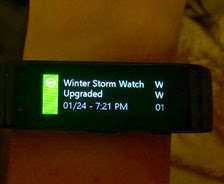The first snowstorm of the year has hit Boston yesterday and with a Blizzard watch currently active it’s an excellent time to talk winter running tips!
There are plenty of useful articles out there but having survived a running streak all through January and February last year and with quite some winter running under my belt let me add my own observations on the topic.
Here are my top 5 tips how to enjoy running in Winter
- Winter running is all about planning. Conditions are going to be bad but they could get worse so be on the lookout for any storm or blizzard warnings, freezing rain or thawing and refreezing. Fresh snow can be quite slippery.
- If you can, go for a run during daytime – visibility is key! For those of us crazy enough to run in the dark on snowy surfaces, make sure you know which trails or roads will be cleared. Ideal is a relatively safe route with lots
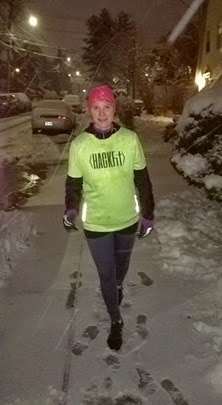 of lighting and without any puddles that could hide beneath the snow.
of lighting and without any puddles that could hide beneath the snow. - Be conservative with your mileage until you are used to winter running. You may power out earlier than you think and get stuck somewhere with only the Uber of shame to rescue you. ;)
- Dressing appropriately is key. I usually dress in layers depending on temperature. My full-on winter outfit comprises running tights and woolen shorts on top to keep the core warm (but you can use normal running shorts as well – it looks dorky but you’ll thank me later, promise!), a wicking running shirt then long-sleeve (also wicking) and running jacket (it’s ultra thin but a great wind breaker and I spray it with water repellant to make it waterproof). If temperatures are well below zero Celsius (approaching 0 Fahrenheit) I also don my bright pink down vest with faux fur collar – it is the most hideous piece of clothing in my wardrobe but there’s nothing like it to maintain core temps even over long runs in winter weather. I also have a number of hats/headbands and gloves that I use depending on temperature, the warmest being fleece.
- Wear a reflective yellow shirt on top for added visibility and attach a high output pulsing red bike light to the back of your collar. This makes sure you can be seen even through snow flurries.
Shoes
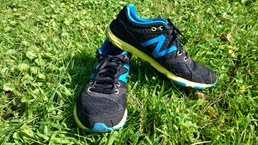 What about shoes you may ask. Well, I wear the same shoes year round, my trusted New Balance W730s as seen on the pictures. They are on the more minimalist side as far as running shoes go. This is a personal preference to do with my relatively flat-arched feet but that makes them perfect for running in the snow I find. I like the fact they let me be in more direct contact with the ground I’m treading on. Lastly, a heart rate monitor is essential to understand what you’re putting your body through and how it reacts to these tricky conditions. I used the MIO Link on my run, a Bluetooth Low Energy monitor that pairs with my phone and works well in colder conditions.
What about shoes you may ask. Well, I wear the same shoes year round, my trusted New Balance W730s as seen on the pictures. They are on the more minimalist side as far as running shoes go. This is a personal preference to do with my relatively flat-arched feet but that makes them perfect for running in the snow I find. I like the fact they let me be in more direct contact with the ground I’m treading on. Lastly, a heart rate monitor is essential to understand what you’re putting your body through and how it reacts to these tricky conditions. I used the MIO Link on my run, a Bluetooth Low Energy monitor that pairs with my phone and works well in colder conditions.
All dressed and ready to go right? Not quite. I always make sure I have credit left on my trusted running companion, the (prepaid) Lumia 630, for emergencies. I also take my license and health insurance card with me just in case. If I am really concerned or it is late or especially slippery I use Track Runner’s live tracking feature so family/friends know where to find me if things go wrong.
During the run:
Start with stretches as long as you can stand it in the cold. (Of course you 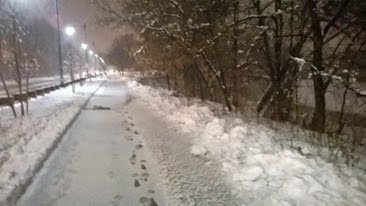 can stretch inside as well but I find it useful to get a feel for what I’m up against to stretch outside).
can stretch inside as well but I find it useful to get a feel for what I’m up against to stretch outside).
I always run with music and get my vital run info via voice notifications so personally running without headphones is not an option. Then again, if ever there was a case to be made against running with headphones on it is in dangerous conditions like snow and darkness. Your call – just don’t have your eyes glued to your phone in those terrible conditions, either.
My first observation on running in the snow: it pays to have worked on stride rate and trained not to overstride. If your body is perfectly centered above the point your foot touches down, there is much less risk you will slip or land at awkward/painful angles. Smaller steps and lower jumps also preserve energy better which is good news as you may be initially underestimating the additional strain the cold has on your body. Mentioning jumps – there will be plenty especially if you are running on sidewalks and snow ploughs were active clearing the roads and leaving those lovely heaps at every street corner. I tend to suck it up and stomp into the heaps rather than risking to jump and overstride and have my feet taken out from underneath me but I admit it’s not the most pleasant sensation ever to dive deep into snow. I guess I just try to minimize injury risk best I can and if it comes at a cost of discomfort that’s fine with me.
 Much as you might want to enjoy the beautiful white scenery, I’d personally not lift my eyes off the ground for too long. You need to know what’s ahead and prepare for what your feet are g
Much as you might want to enjoy the beautiful white scenery, I’d personally not lift my eyes off the ground for too long. You need to know what’s ahead and prepare for what your feet are g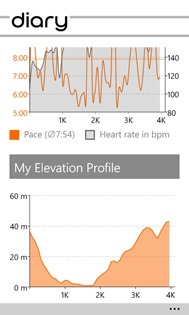 oing to encounter.
oing to encounter.
I’ve touched on this above when writing about the heart rate monitor but I will say it again. Running in those colder temperatures will exhaust you much more than you may be expecting so it is important to listen to your body as well as Track Runner voice notifications about your heart rate and react before things get out of hand. I ran up a very slippery snowy hill last night (look at the elevation profile!) which made my heart rate shoot into speed zone, so I deliberately walked a few steps to bring it down. You won’t beat your PR in those conditions anyway. It’s much more about keeping at it and practicing endurance so don’t overexert yourself.
What’s your experience with running in the snow? Any questions or stories to share? Let us know in the comments!

